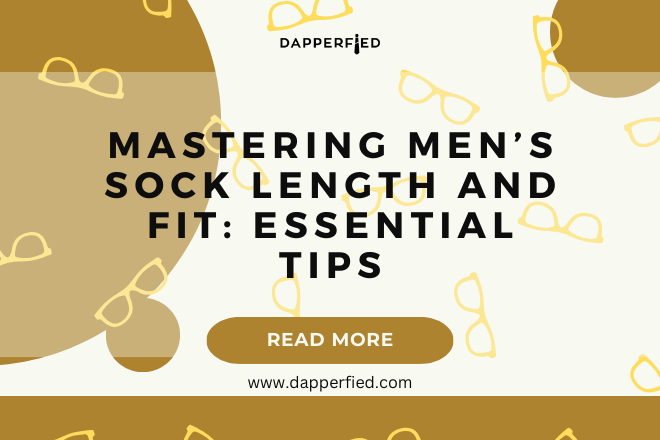
Men's Style
Essential Sock Care Tips for Men
Proper sock care is crucial for maintaining the quality, longevity, and hygiene of your socks. Socks are essential daily wear items that provide comfort and protection for feet. By implementing proper care techniques, you can prevent premature wear and tear, maintain elasticity, and preserve the appearance and feel of your socks.
Proper care also helps prevent unpleasant odors and bacterial growth, which can lead to foot health issues. Effective sock care can result in long-term cost savings. By washing, drying, and storing socks correctly, you can extend their lifespan and reduce the frequency of replacements.
This is particularly beneficial for high-quality socks designed for durability. Prioritizing sock care helps avoid the need for frequent purchases due to premature wear or damage, ultimately saving time and money. In summary, proper sock care is essential for maintaining quality, hygiene, and longevity.
It also contributes to cost-effectiveness by maximizing the lifespan of socks and minimizing the need for frequent replacements. Implementing good sock care practices is an important aspect of overall wardrobe maintenance.
Key Takeaways
- Proper sock care is important for maintaining their quality and longevity
- Choosing the right socks for different activities and seasons can make a big difference in comfort and durability
- Washing and drying techniques, such as using gentle cycles and air drying, can help prevent damage to socks
- Storing socks properly, such as in pairs and in a cool, dry place, can help maintain their shape and prevent stretching
- Preventing wear and tear by avoiding walking barefoot and trimming toenails can extend the life of socks
- Maintaining sock elasticity by avoiding excessive stretching and using fabric softeners can help socks retain their shape and fit
- Knowing when to replace socks, such as when they become thin or lose their elasticity, is important for maintaining foot health and comfort
Choosing the Right Socks
Material Matters
The material of the socks is a crucial factor to consider. Different materials offer different benefits, so it’s essential to choose a material that aligns with your specific preferences and requirements. For example, cotton socks are breathable and comfortable, making them a great choice for everyday wear, while wool socks are warm and moisture-wicking, making them ideal for outdoor activities in cold weather. Additionally, synthetic materials like polyester and nylon are durable and quick-drying, making them suitable for athletic activities.
Style and Length Considerations
In addition to material, the style and length of the socks are also important factors to consider. Different styles, such as crew socks, ankle socks, and knee-high socks, offer varying levels of coverage and support, so it’s important to choose a style that suits your footwear and activity. For example, crew socks are versatile and can be worn with a wide range of shoes, while ankle socks are great for low-cut footwear and warm-weather activities.
Specialized Socks for Specific Needs
Furthermore, there are specialized socks designed to meet specific needs. Compression socks, for instance, are designed to improve circulation and reduce swelling, making them a great choice for athletes and individuals with certain medical conditions. By considering the style and length of the socks, you can ensure that you choose a pair that provides the right level of comfort, support, and functionality for your specific needs.
Washing and Drying Techniques
Proper washing and drying techniques are crucial for maintaining the quality and integrity of your socks. When it comes to washing your socks, it’s important to follow the care instructions provided by the manufacturer to ensure that you use the appropriate water temperature, detergent, and washing cycle. In general, it’s best to wash socks in cold or warm water to prevent shrinkage and preserve the elasticity of the fabric.
Additionally, using a gentle detergent can help prevent damage to the fibers and maintain the softness and color of the socks. It’s also important to avoid using bleach or fabric softener when washing socks, as these can cause discoloration and break down the fibers over time. By following these washing techniques, you can ensure that your socks remain clean and in good condition after each wash.
When it comes to drying your socks, it’s best to air dry them whenever possible to prevent damage from high heat. Hanging your socks to air dry or laying them flat on a drying rack can help preserve their shape and elasticity while also reducing the risk of shrinkage. If you need to use a dryer, it’s important to use a low heat setting to prevent damage to the fabric and elastic.
Additionally, using dryer balls or wool dryer balls can help speed up the drying process and prevent static cling without the need for high heat or fabric softener. By following these drying techniques, you can ensure that your socks maintain their quality and elasticity while also reducing the risk of damage from high heat or mechanical agitation.
Storing Socks Properly
| Method | Advantages | Disadvantages |
|---|---|---|
| Folding | Maximizes space | May cause stretching |
| Rolling | Prevents stretching | Takes more time |
| Using dividers | Organizes socks | Requires additional storage |
Properly storing your socks is essential for preventing damage and maintaining their quality between wears. One of the most important aspects of sock storage is ensuring that they are clean and completely dry before being put away. Storing damp or dirty socks can lead to unpleasant odors, mold growth, and deterioration of the fabric over time.
Therefore, it’s important to make sure that your socks are thoroughly cleaned and dried before being stored to keep them in good condition. Additionally, it’s best to store socks in a cool, dry place away from direct sunlight to prevent fading and damage from heat or moisture. By following these storage techniques, you can ensure that your socks remain clean, fresh, and in good condition until their next use.

Another important aspect of sock storage is organizing them in a way that prevents stretching or misshaping. Folding socks together or using sock organizers can help maintain their shape and elasticity while also making it easier to find matching pairs when getting dressed. Additionally, storing socks in a drawer or container with dividers can help prevent them from getting tangled or mixed up with other clothing items.
By organizing your socks in a way that prevents stretching and misshaping, you can ensure that they remain comfortable and supportive when worn while also making it easier to keep track of your sock collection.
Preventing Wear and Tear
Preventing wear and tear is essential for maintaining the longevity and quality of your socks. One of the most effective ways to prevent wear and tear is by wearing the right socks for the right activities. For example, wearing athletic socks designed for running or hiking can provide extra cushioning and support where it’s needed most, reducing the risk of premature wear from repetitive impact.
Similarly, wearing moisture-wicking socks during intense physical activities can help prevent friction and blisters, reducing the risk of damage to the fabric. By choosing socks that are specifically designed for the activities you engage in, you can minimize wear and tear while also maximizing comfort and performance. Another effective way to prevent wear and tear is by rotating your sock collection regularly.
Wearing the same pair of socks day after day can lead to excessive wear in specific areas, such as the heels and toes, which can cause holes or thinning of the fabric over time. By rotating through different pairs of socks throughout the week, you can distribute the wear more evenly across your collection, reducing the risk of premature damage to any one pair. Additionally, regularly inspecting your socks for signs of wear and addressing any issues promptly, such as mending small holes or reinforcing thinning areas with patches or darning, can help extend their lifespan and prevent further damage.
Maintaining Sock Elasticity
Knowing When to Replace Socks
Knowing when to replace socks is essential for maintaining foot health and overall comfort. Over time, socks naturally experience wear and tear from regular use, leading to thinning fabric, stretched-out elastic, or holes in high-friction areas like heels and toes. When these signs of wear become noticeable or start affecting the comfort or performance of the socks, it’s time to consider replacing them with new pairs.
Wearing worn-out socks can lead to discomfort, blisters, or foot health issues due to reduced support and protection. Therefore, it’s important to regularly inspect your sock collection for signs of wear and address any issues promptly by replacing damaged pairs with new ones. Additionally, knowing when to replace socks is also important for maintaining hygiene and preventing odor-causing bacteria growth.
Over time, socks can accumulate sweat, dead skin cells, and bacteria from regular wear, leading to unpleasant odors that are difficult to eliminate even with regular washing. When socks become excessively smelly despite thorough cleaning or develop persistent stains that cannot be removed, it may be time to replace them with fresh pairs. By being mindful of signs of wear as well as changes in odor or cleanliness over time, you can ensure that your sock collection remains comfortable, hygienic, and supportive for everyday wear.
In conclusion, proper sock care is essential for maintaining the quality, comfort, hygiene, and longevity of your sock collection. By choosing the right socks for your specific needs and lifestyle, following proper washing and drying techniques, storing them correctly between wears, preventing wear and tear through mindful use and regular inspection, maintaining their elasticity through gentle handling and choosing high-quality options with reinforced bands when possible, as well as knowing when to replace worn-out pairs with new ones when necessary; you can ensure that your sock collection remains comfortable, supportive, hygienic, and in good condition for long-term wear. Taking the time to care for your socks properly not only benefits their durability but also saves you money in the long run by reducing the need for frequent replacements due to premature wear or damage.

Overall, proper sock care is an important aspect of maintaining foot health as well as maximizing the lifespan of your wardrobe essentials.
If you’re looking for more tips on men’s fashion and grooming, be sure to check out this article on selecting the perfect designer shirt. It’s important to pay attention to the details when it comes to your wardrobe, and this article offers great advice on finding the right shirt for your style.
FAQs
What are some general sock care tips for men?
Some general sock care tips for men include washing socks in cold water, avoiding bleach and fabric softeners, air drying or using a low heat setting in the dryer, and storing socks in a cool, dry place.
How often should men wash their socks?
Men should wash their socks after each wear to maintain hygiene and prevent the buildup of bacteria and odor.
What is the best way to wash socks?
The best way to wash socks is to turn them inside out and wash them in cold water with a mild detergent. Avoid using bleach and fabric softeners, as they can damage the fabric and elastic in the socks.
How should men dry their socks?
Men should air dry their socks by laying them flat or hanging them up. If using a dryer, it’s best to use a low heat setting to prevent shrinkage and damage to the fabric and elastic.
How should men store their socks?
Men should store their socks in a cool, dry place to prevent moisture and mold growth. It’s also a good idea to keep socks in a drawer or organizer to prevent stretching and misshaping.

















